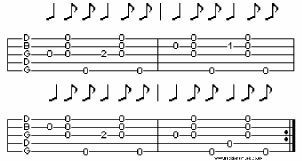A Book Of Five Strings - online tutorial
Strategies for mastering the art of old time banjo.
| Share page | Visit Us On FB |
|
Example Seven
In this last example of the double thumb let's look at how to convert a basic frailing strum into a string of single notes. |
||
|
|
||
 |
||
|
|
||
|
Is this tab we have a simple melody played with the basic frailing strum.
In order to convert this to single notes we can double thumb the "bump" but we have to fill in the "dit-ty" somehow.
That's the kicker. We can do pretty much whatever we want in the confines of a measure, but we have to make musical sense while we're doing it. If we turn the quarter notes into eighth notes we have to do something in place of the strum thumb.
The next tab illustrates one solution to this problem. |
||
|
|
||
 |
||
|
|
||
|
What we have done here is replaced the strum-thumb with a double thumb. That gives us the space we need between the notes to keep the melody intact and creates an interesting rhythm at the same time. I left the last quarter note and two eighth note pattern intact to give the exercise a sense of conclusion. If you want to play this in a repeating pattern for practice you can change that to double thumbs on your own.
Phantom Effects
Up to this point every technique we have been exploring involves playing one note at a time. This makes sense because in old time banjo we are only working with our thumb and middle fingernail in a downward motion. |
||
|
|
||
|
In order to create at least the illusion that there is more than one string being played we have to bring the left hand into the game with what I usually group under the general heading of phantom effects. |
||